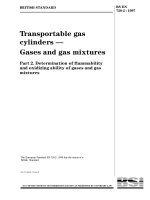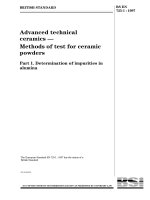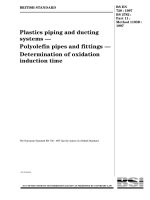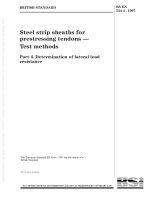Bsi bs en 01668 1997
Bạn đang xem bản rút gọn của tài liệu. Xem và tải ngay bản đầy đủ của tài liệu tại đây (112.64 KB, 10 trang )
BRITISH STANDARD
Welding consumables Ð
Rods, wires and deposits for
tungsten inert gas welding of
non alloy and fine grain
steels Ð
Classification
The European Standard EN 1668 : 1997 has the status of a
British Standard
ICS 25.160.20
NO COPYING WITHOUT BSI PERMISSION EXCEPT AS PERMITTED BY COPYRIGHT LAW
|
|
|
|
|
|
|
|
|
|
|
|
|
|
|
|
|
|
|
|
|
|
|
|
|
|
|
|
|
|
|
|
|
|
|
|
|
|
|
|
|
|
|
|
|
|
|
|
|
|
|
|
|
|
|
|
|
|
|
|
|
|
|
|
|
|
|
|
|
|
|
|
|
|
|
|
|
|
|
|
|
|
|
|
|
|
|
|
|
|
|
|
|
|
|
|
|
|
|
|
|
|
|
|
|
|
|
|
|
|
|
|
|
|
|
|
|
|
|
|
|
|
|
|
|
|
|
|
|
BS EN
1668 : 1997
BS EN 1668 : 1997
National foreword
This British Standard is the English language version of EN 1668 : 1997. It partially
supersedes BS 2901 : Part 1 : 1983, which is withdrawn.
The UK participation in its preparation was entrusted to Technical Committee
WEE/39, Welding consumables, which has the responsibility to:
± aid enquirers to understand the text;
± present to the responsible European committee any enquiries on the
interpretation, or proposals for change, and keep the UK interests informed;
± monitor related international and European developments and promulgate
them in the UK.
A list of organizations represented on this committee can be obtained on request to
its secretary.
Cross-references
The British Standards which implement international or European publications
referred to in this document may be found in the BSI Standards Catalogue under the
section entitled `International Standards Correspondence Index', or by using the
`Find' facility of the BSI Standards Electronic Catalogue.
Compliance with a British Standard does not of itself confer immunity
from legal obligations.
Summary of pages
This document comprises a front cover, an inside front cover, the EN title page,
pages 2 to 6, an inside back cover and a back cover.
This British Standard, having
been prepared under the
direction of the Engineering
Sector Board, was published
under the authority of the
Standards Board and comes into
effect on 15 December 1997
BSI 1997
ISBN 0 580 28921 4
Amendments issued since publication
Amd. No.
Date
Text affected
EN 1668
EUROPEAN STANDARD
NORME EUROPÊENNE
EUROPẰISCHE NORM
August 1997
ICS 25.160.20
Descriptors: Welding, arc welding, filler wire, filler metal, steels, unalloyed steels, characteristics, chemical composition, mechanical
properties, classifications
English version
Welding consumables Ð Rods, wires and deposits
for tungsten inert gas welding of non alloy
and fine grain steels Ð Classification
Produits consommables pour le soudage Ð
Baguettes, fils d'apport et deÂpoÃts pour le soudage
sous atmospheÁre inerte avec eÂlectrode reÂfractaire
des aciers non allieÂs et des aciers aÁ grains fins Ð
Classification
SchweibzusaÈtze Ð StaÈbe, DraÈhte und Schweibgut
zum Wolfram-Schutzgasschweiben von unlegierten
StaÈhlen und FeinkornstaÈhlen Ð Einteilung
This European Standard was approved by CEN on 1997-07-24. CEN members are
bound to comply with the CEN/CENELEC Internal Regulations which stipulate the
conditions for giving this European Standard the status of a national standard
without any alteration.
Up-to-date lists and bibliographical references concerning such national standards
may be obtained on application to the Central Secretariat or to any CEN member.
This European Standard exists in three official versions (English, French, German).
A version in any other language made by translation under the responsibility of a
CEN member into its own language and notified to the Central Secretariat has the
same status as the official versions.
CEN members are the national standards bodies of Austria, Belgium, Czech
Republic, Denmark, Finland, France, Germany, Greece, Iceland, Ireland, Italy,
Luxembourg, Netherlands, Norway, Portugal, Spain, Sweden, Switzerland and
United Kingdom.
CEN
European Committee for Standardization
Comite EuropeÂen de Normalisation
EuropaÈisches Komitee fuÈr Normung
Central Secretariat: rue de Stassart 36, B-1050 Brussels
1997 CEN Ð All rights of exploitation in any form and by any means reserved worldwide for CEN national
Members.
Ref. No. EN 1668 : 1997 E
Page 2
EN 1668 : 1997
Foreword
This European Standard has been prepared by
Technical Committee CEN/TC 121, Welding, the
secretariat of which is held by DS.
This European Standard shall be given the status of a
national standard, either by publication of an identical
text or by endorsement, at the latest by February 1998,
and conflicting national standards shall be withdrawn
at the latest by February 1998.
According to the CEN/CENELEC Internal Regulations,
the national standards organizations of the following
countries are bound to implement this European
Standard: Austria, Belgium, Czech Republic, Denmark,
Finland, France, Germany, Greece, Iceland, Ireland,
Italy, Luxembourg, Netherlands, Norway, Portugal,
Spain, Sweden, Switzerland and the United Kingdom.
Contents
Foreword
Introduction
1
Scope
2
Normative references
3
Classification
4
Symbols and requirements
4.1 Symbol for the product/process
4.2 Symbol for strength and elongation of
all-weld metal
4.3 Symbol for impact properties of
all-weld metal
4.4 Symbol for the chemical composition
of rods/wires
5
Mechanical tests
5.1 General
5.2 Preheating and interpass temperature
5.3 Welding conditions
6
Chemical analysis
7
Technical delivery conditions
8
Designation
Annex A (informative) Bibliography
Page
2
3
3
3
3
3
3
3
4
4
4
4
4
4
5
5
5
6
BSI 1997
Page 3
EN 1668 : 1997
Introduction
3 Classification
This standard proposes a classification in order to
designate rods and wires in terms of the yield strength,
tensile strength and elongation of the all-weld metal.
The ratio of yield to tensile strength of weld metal is
generally higher than that of parent metal. Users
should note that matching weld metal yield strength to
parent metal yield strength will not necessarily ensure
that the weld metal tensile strength matches that of the
parent material. Where the application requires
matching tensile strength, therefore, selection of the
consumable should be made by reference to column 3
of table 1.
It should be noted that the mechanical properties of
all-weld metal test specimens used to classify the rods
and wires will vary from those obtained in production
joints because of differences in welding procedure
such as diameter, width of weave, welding position and
material composition.
The classification includes all-weld metal properties
obtained with a rod or wire and the shielding gas
EN 439-I1. The classification is based on the rod/wire
diameter 2,4 mm.
It shall be noted that only one shielding gas is used for
classification purposes. The designation does therefore
not give any symbol for shielding gas.
The classification is divided into four parts:
1) the first part gives a symbol indicating the
product/process to be identified;
2) the second part gives a symbol indicating the
strength and the elongation of all-weld metal;
3) the third part gives a symbol indicating the
impact properties of all-weld metal;
4) the fourth part gives a symbol indicating the
chemical composition of rods or wires.
1 Scope
This standard specifies requirements for classification
of rods, wires and all-weld metal in the as-welded
condition for tungsten inert gas welding of non alloy
and fine grain steels with a minimum yield strength of
up to 500 N/mm2 in the as-welded condition.
2 Normative references
This European Standard incorporates by dated or
undated reference, provisions from other publications.
These normative references are cited at the
appropriate places in the text and the publications are
listed hereafter. For dated references, subsequent
amendments to or revisions of any of these
publications apply to this European Standard only
when incorporated in it by amendment or revision. For
undated references the latest edition of the publication
referred to applies.
EN 439
Welding consumables Ð Shielding
gases for arc welding and cutting
EN 759
Welding consumables Ð Technical
delivery conditions for welding filler
metals Ð Type of product,
dimensions, tolerances and marking
EN 1597-1
Welding consumables Ð
Test methods Ð
Part 1: Test assembly for all-weld
metal specimens in steel, nickel and
nickel alloys
EN ISO 13916 Welding Ð Guidance for the
measurement of preheating
temperature, interpass temperature
and preheat maintenance
temperature (ISO 13916 : 1996)
ISO 31-0 : 1992 Quantities and units Ð
Part 0: General principles
BSI 1997
4 Symbols and requirements
4.1 Symbol for the product/process
The symbol for a rod/wire for the tungsten inert gas
welding process and/or the resulting weld deposit shall
be the letter W.
4.2 Symbol for strength and elongation of
all-weld metal
The symbol in table 1 indicates yield strength, tensile
strength and elongation of the all-weld metal in the
as-welded condition in accordance with clause 5.
Table 1. Symbol for strength and elongation of
all-weld metal
Symbol
Minimum1)
yield strength
ReL
N/mm2
Tensile
strength
Rm
N/mm2
Minimum
elongation2)
A
%
35
355
440 to 570
22
38
380
470 to 600
20
42
420
500 to 640
20
46
460
530 to 680
20
50
500
560 to 720
18
1)
For yield strength the lower yield (ReL) shall be used when
yielding occurs, otherwise the 0,2 % proof strength (Rpo,2) shall
be used.
2)
Gauge length is equal to five times the test specimen diameter.
Page 4
EN 1668 : 1997
4.3 Symbol for impact properties of all-weld
metal
The symbol in table 2 indicates the temperature at
which an average impact energy of 47 J is achieved
under conditions given in clause 5. Three specimens
shall be tested. Only one individual value may be lower
than 47 J but not lower than 32 J. When an all-weld
metal has been classified for a certain temperature, it
automatically covers any higher temperature in table 2.
Table 2. Symbol for impact properties
Symbol
Temperature for minimum average
impact energy of 47 J
ÊC
Z
No requirements
A
+ 20
0
0
2
2 20
3
2 30
4
2 40
5
2 50
6
2 60
5 Mechanical tests
5.1 General
Tensile and impact tests and any required retests shall
be carried out in the as-welded condition using an
all-weld metal test assembly type 3 prepared in
accordance with EN 1597-1 using 2,4 mm rods/wires
and welding conditions as described in 5.2 and 5.3.
5.2 Preheating and interpass temperatures
Preheating is not required, welding can start from
room temperature.
The interpass temperature shall be measured using
temperature indicator crayons, surface thermometers
or thermocouples, see EN ISO 13916.
The interpass temperature shall not exceed 250 ÊC. If,
after any pass, this interpass temperature is exceeded,
the test assembly shall be cooled in air to a
temperature below that limit.
5.3 Welding conditions
The welding conditions and details of test assembly in
table 4 shall be used.
The direction of welding to complete a layer consisting
of two passes shall not vary, but the direction of
welding of layers shall be alternated.
4.4 Symbol for the chemical composition of
rods/wires
The symbol in table 3 indicates the chemical
composition of the rod/wire and includes an indication
of characteristic alloying elements.
Table 3. Symbol for chemical composition of rods/wires
Symbol Chemical composition % (m/m)
C
Si
1) 2) 3)
Mn
P
S
Mo
Ni
Al
Ti + Zr
W0
Any agreed analysis not specified in this standard
W2Si
0,06 to 0,14 0,50 to 0,80 0,90 to 1,30 0,025 0,025 Ð
Ð
Ð
Ð
W3Si1 0,06 to 0,14 0,70 to 1,00 1,30 to 1,60 0,025 0,025 Ð
Ð
Ð
Ð
W4Si1 0,06 to 0,14 0,80 to 1,20 1,60 to 1,90 0,025 0,025 Ð
Ð
Ð
Ð
W2Ti
Ð
0,05 to 0,20 0,05 to 0,25
0,04 to 0,14 0,40 to 0,80 0,90 to 1,40 0,025 0,025 Ð
W3Ni1 0,06 to 0,14 0,50 to 0,90 1,00 to 1,60 0,020 0,020 Ð
0,80 to 1,50 Ð
Ð
W2Ni2 0,06 to 0,14 0,40 to 0,80 0,80 to 1,40 0,020 0,020 Ð
2,10 to 2,70 Ð
Ð
W2Mo 0,08 to 0,12 0,30 to 0,70 0,90 to 1,30 0,020 0,020 0,40 to 0,60 Ð
Ð
Ð
1)
Finished product chemical composition. If not specified: Mo < 0,15 %, Ni < 0,15 %, Cr < 0,15 %, V < 0,03 %, Al < 0,02 %, Ti + Zr < 0,15 %,
Cu < 0,35 % (residual in steel plus any coating).
2)
Single values shown in the table are maximum values.
3)
The results shall be rounded to the same number of significant figures as in the specified value using the rule A in accordance with
annex B of ISO 31-0 : 1992.
BSI 1997
Page 5
EN 1668 : 1997
8 Designation
Table 4. Welding conditions
Conditions
Parameters
Rod/wire diameter mm
2,4
Length of weld deposit mm
min. 200
Type of
current1)
Welding current A
Welding speed mm/min
Interpass temperature range ÊC
(no preheat)
1)
d.c.
240 ± 20
140 ± 20
# 250
d.c. means direct current. Electrode negative.
6 Chemical analysis
Chemical analysis is performed on specimens of the
rod/wire. Any analytical technique can be used, but in
case of dispute reference shall be made to established
published methods.
NOTE. See annex A.
7 Technical delivery conditions
Technical delivery conditions shall meet the
requirements in EN 759.
BSI 1997
The designation of the rod or wire shall follow the
principles given in the example below:
Example:
A weld deposit produced by tungsten inert gas
welding (W) having a minimum yield strength of
460 N/mm2 (46) and a minimum average impact energy
of 47 J at 2 30 ÊC (3) produced under argon shield,
EN 439-I1, using the rod W3Si1 is designated:
Rod EN 1668 2 W 46 3 W3Si1
A rod complying with the chemical requirement of
W3Si1 in table 3 is designated:
Rod EN 1668 2 W3Si1
where:
EN 1668 = standard number;
W
= rod/wire and or deposit/tungsten inert
gas welding (see 4.1);
46
= strength and elongation (see table 1);
3
= impact properties (see table 2);
W3Si1
= chemical composition of rod/wire
(see table 3).
Page 6
EN 1668 : 1997
Annex A (informative)
Bibliography
A.1 Handbuch fuÈr das EisenhuÈttenlaboratorium,
VdEh, DuÈsseldorf
A.2 BS 6200-3 Sampling of iron, steel and other
ferrous metals Ð Part 3 : Methods of analysis
A.3 CR 10261 ECISS Information Circular 11 Ð Iron
and Steel Ð Review of available methods of
chemical analysis
BSI 1997
blank
BSI
389 Chiswick High Road
London
W4 4AL
|
|
|
|
|
|
|
|
|
|
|
|
|
|
|
|
|
|
|
|
|
|
|
|
|
|
|
|
|
|
|
|
|
|
|
|
|
|
|
|
|
|
|
|
|
|
|
|
|
|
|
|
|
|
|
|
|
|
|
|
|
|
|
|
|
|
|
|
|
|
|
|
|
|
|
|
|
|
|
|
|
|
|
|
|
|
|
|
|
|
|
|
|
|
|
|
|
|
|
|
|
|
|
|
|
|
|
|
|
|
|
|
|
|
|
|
|
|
|
|
|
|
|
|
|
|
|
BSI Ð British Standards Institution
BSI is the independent national body responsible for preparing British Standards. It
presents the UK view on standards in Europe and at the international level. It is
incorporated by Royal Charter.
Revisions
British Standards are updated by amendment or revision. Users of British Standards
should make sure that they possess the latest amendments or editions.
It is the constant aim of BSI to improve the quality of our products and services. We
would be grateful if anyone finding an inaccuracy or ambiguity while using this
British Standard would inform the Secretary of the technical committee responsible,
the identity of which can be found on the inside front cover. Tel: 020 8996 9000.
Fax: 020 8996 7400.
BSI offers members an individual updating service called PLUS which ensures that
subscribers automatically receive the latest editions of standards.
Buying standards
Orders for all BSI, international and foreign standards publications should be
addressed to Customer Services. Tel: 020 8996 9001. Fax: 020 8996 7001.
In response to orders for international standards, it is BSI policy to supply the BSI
implementation of those that have been published as British Standards, unless
otherwise requested.
Information on standards
BSI provides a wide range of information on national, European and international
standards through its Library and its Technical Help to Exporters Service. Various
BSI electronic information services are also available which give details on all its
products and services. Contact the Information Centre. Tel: 020 8996 7111.
Fax: 020 8996 7048.
Subscribing members of BSI are kept up to date with standards developments and
receive substantial discounts on the purchase price of standards. For details of
these and other benefits contact Membership Administration. Tel: 020 8996 7002.
Fax: 020 8996 7001.
Copyright
Copyright subsists in all BSI publications. BSI also holds the copyright, in the UK, of
the publications of the international standardization bodies. Except as permitted
under the Copyright, Designs and Patents Act 1988 no extract may be reproduced,
stored in a retrieval system or transmitted in any form or by any means ± electronic,
photocopying, recording or otherwise ± without prior written permission from BSI.
This does not preclude the free use, in the course of implementing the standard, of
necessary details such as symbols, and size, type or grade designations. If these
details are to be used for any other purpose than implementation then the prior
written permission of BSI must be obtained.
If permission is granted, the terms may include royalty payments or a licensing
agreement. Details and advice can be obtained from the Copyright Manager.
Tel: 020 8996 7070.









